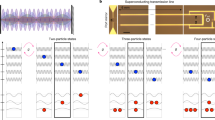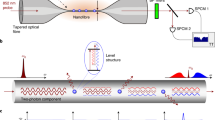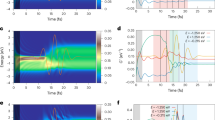Abstract
In quantum optics, the radiative quantum cascade—the consecutive emission of photons from a ladder of energy levels—is of fundamental importance. Two-photon cascaded emission has been instrumental in pioneering experiments to test Bell inequalities and generate entangled photon pairs. More recently, correlated and entangled photon pairs in the visible and microwave domains have been demonstrated using solid-state systems. These experiments rely on the nonlinear nature of the underlying energy ladder, which enables the direct excitation and probing of specific single-photon transitions. Here we use exciton–polaritons to explore the cascaded emission of photons in the regime where individual transitions of the ladder are not resolved. We excite a polariton quantum cascade by off-resonant laser excitation and probe the emitted luminescence using a combination of spectral filtering and correlation spectroscopy. The measured photon–photon correlations exhibit a strong dependence on the polariton energy and therefore on the underlying polaritonic interaction strength, with clear signatures of many-body Feshbach resonances. Our experiment establishes photon cascade correlation spectroscopy as a highly sensitive tool to study the underlying quantum properties of novel semiconductor materials and many-body quantum phenomena.
This is a preview of subscription content, access via your institution
Access options
Access Nature and 54 other Nature Portfolio journals
Get Nature+, our best-value online-access subscription
$29.99 / 30 days
cancel any time
Subscribe to this journal
Receive 12 print issues and online access
$209.00 per year
only $17.42 per issue
Buy this article
- Purchase on Springer Link
- Instant access to full article PDF
Prices may be subject to local taxes which are calculated during checkout



Similar content being viewed by others
Data availability
All the data that support the plots within this Article and the Supplementary Information and other findings of this study are available from the corresponding author upon reasonable request.
Code availability
All the codes that support the plots within this Article and the Supplementary Information and other findings of this study are available from the corresponding author upon reasonable request.
References
Carusotto, I. & Ciuti, C. Quantum fluids of light. Rev. Mod. Phys. 85, 299 (2013).
Amo, A. Superfluidity of polaritons in semiconductor microcavities. Nat. Phys. 5, 805–810 (2009).
Amo, A. Polariton superfluids reveal quantum hydrodynamic solitons. Science 332, 1167–1170 (2011).
Nardin, G. Hydrodynamic nucleation of quantized vortex pairs in a polariton quantum fluid. Nat. Phys. 7, 635–641 (2011).
Karr, J. P. H., Baas, A., Houdré, R. & Giacobino, E. Squeezing in semiconductor microcavities in the strong-coupling regime. Phys. Rev. A 69, 031802 (2004).
Boulier, T. Polariton-generated intensity squeezing in semiconductor micropillars. Nat. Commun. 5, 3260 (2014).
Kuriakose, T. Few-photon all-optical phase rotation in a quantum-well micropillar cavity. Nat. Photon. 16, 566–569 (2022).
Muñoz-Matutano, G. Emergence of quantum correlations from interacting fibre-cavity polaritons. Nat. Mater. 18, 213–218 (2019).
Delteil, A. Towards polariton blockade of confined exciton-polaritons. Nat. Mater. 18, 219–222 (2019).
Takemura, N., Trebaol, S., Wouters, M., Portella-Oberli, M. T. & Deveaud, B. Polaritonic Feshbach resonance. Nat. Phys. 10, 500–504 (2014).
Turner, D. B. & Nelson, K. A. Coherent measurements of high-order electronic correlations in quantum wells. Nature 466, 1089–1092 (2010).
Wen, P., Christmann, G., Baumberg, J. J. & Nelson, K. A. Influence of multi-exciton correlations on nonlinear polariton dynamics in semiconductor microcavities. New J. Phys. 15, 025005 (2013).
Besga, B. Polariton boxes in a tunable fiber cavity. Phys. Rev. Appl. 3, 014008 (2015).
Fink, T., Schade, A., Höfling, S., Schneider, C. & Imamoğlu, A. Signatures of a dissipative phase transition in photon correlation measurements. Nat. Phys. 14, 365–369 (2018).
Scully, M. O. & Lamb, Jr. W. E. Quantum theory of an optical maser. I. General theory. Phys. Rev. 159, 208 (1967).
Klaas, M. Photon-number-resolved measurement of an exciton-polariton condensate. Phys. Rev. Lett. 121, 047401 (2018).
Silva, B. The colored Hanbury Brown-Twiss effect. Sci. Rep. 6, 2045–2322 (2016).
Verger, A., Ciuti, C. & Carusotto, I. Polariton quantum blockade in a photonic dot. Phys. Rev. B 73, 193306 (2006).
Liew, T. C. H. & Savona, V. Single photons from coupled quantum modes. Phys. Rev. Lett. 104, 183601 (2010).
Vaneph, C. Observation of the unconventional photon blockade in the microwave domain. Phys. Rev. Lett. 121, 043602 (2018).
Snijders, H. J. Observation of the unconventional photon blockade. Phys. Rev. Lett. 121, 043601 (2018).
Hanschke, L. Origin of antibunching in resonance fluorescence. Phys. Rev. Lett. 125, 170402 (2020).
Phillips, C. L. Photon statistics of filtered resonance fluorescence. Phys. Rev. Lett. 125, 043603 (2020).
Foster, A. P. Tunable photon statistics exploiting the Fano effect in a waveguide. Phys. Rev. Lett. 122, 173603 (2019).
Casalengua, E. Z., López Carre no, J. C., Laussy, F. P. & del Valle, E. Tuning photon statistics with coherent fields. Phys. Rev. A 101, 063824 (2020).
Takemura, N. Spin anisotropic interactions of lower polaritons in the vicinity of polaritonic Feshbach resonance. Phys. Rev. B 95, 205303 (2017).
Levinsen, J., Marchetti, F., Keeling, J. & Parish, M. Spectroscopic signatures of quantum many-body correlations in polariton microcavities. Phys. Rev. Lett. 123, 266401 (2019).
Bleu, O., Levinsen, J. & Parish, M. Interplay between polarization and quantum correlations of confined polaritons. Phys. Rev. B 104, 035304 (2021).
Christensen, E. R. et al. Microscopic theory of cavity-enhanced interactions of dipolaritons. Preprint at https://arxiv.org/abs/2212.02597 (2022).
Shimazaki, Y. Strongly correlated electrons and hybrid excitons in a moiré heterostructure. Nature 580, 472–477 (2020).
Smoleński, T. Signatures of Wigner crystal of electrons in a monolayer semiconductor. Nature 595, 53–57 (2021).
Acknowledgements
We would like to thank G. M. Matutano and A. Wood for early experimental work, and A. Auffeves for early contributions towards the theoretical modelling. We also thank D. D. Bernardis for discussions. We acknowledge financial support from the Australian Research Council Centre of Excellence for Engineered Quantum Systems EQUS (CE170100009). I.C. acknowledges financial support from the Provincia Autonoma di Trento, from the Q@TN initiative and from PNRR MUR project PE0000023-NQSTI. C2N acknowledges support from the Paris Ile-de-France Region in the framework of DIM SIRTEQ, the French RENATECH network, the H2020-FETFLAG project PhoQus (820392), the QUANTERA project Interpol (ANR-QUAN-0003-05) and the European Research Council (ERC) under the European Union’s Horizon 2020 research and innovation programme (project ARQADIA, grant agreement no. 949730). M.R. acknowledges support from the Centre for Quantum Technologies’s Exploratory Initiative program.
Author information
Authors and Affiliations
Contributions
L.S. built the experimental setup, performed the experiments and analysed the data. C.E. and L.S. realized the theoretical calculations and numerical simulations, with the help of M.J. and M.R. S.R. and A.L. contributed to the design of the sample structure and M.M. and A.L. grew the sample by molecular-beam epitaxy. J.B., S.R. and I.C. participated in the scientific discussions to finalize the work. L.S., C.E., M.R. and T.V. wrote the manuscript, with varying contributions from all authors. L.S., M.R. and T.V. conceived the idea for the experiment. M.R. and T.V. supervised the project.
Corresponding author
Ethics declarations
Competing interests
The authors declare no competing interests.
Peer review
Peer review information
Nature Physics thanks the anonymous reviewers for their contribution to the peer review of this work.
Additional information
Publisher’s note Springer Nature remains neutral with regard to jurisdictional claims in published maps and institutional affiliations.
Supplementary information
Supplementary Information
Supplementary Figs. 1–21.
Rights and permissions
Springer Nature or its licensor (e.g. a society or other partner) holds exclusive rights to this article under a publishing agreement with the author(s) or other rightsholder(s); author self-archiving of the accepted manuscript version of this article is solely governed by the terms of such publishing agreement and applicable law.
About this article
Cite this article
Scarpelli, L., Elouard, C., Johnsson, M. et al. Probing many-body correlations using quantum-cascade correlation spectroscopy. Nat. Phys. 20, 214–218 (2024). https://doi.org/10.1038/s41567-023-02322-x
Received:
Accepted:
Published:
Issue Date:
DOI: https://doi.org/10.1038/s41567-023-02322-x



